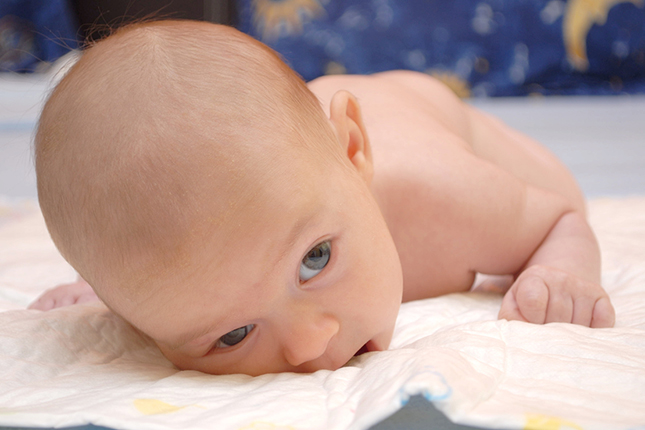Newbies
Fontanels: The Soft Spots on Your Baby's Head
Please be advised, this transcription was performed from a company independent of New Mommy Media, LLC. As such, translation was required which may alter the accuracy of the transcription.
[Theme Music]
DR. STACEY MERLO: Your baby’s head is uniquely made to mold for birth and move to accommodate a growing and developing brain. You may have been told to be extra careful with the soft spot on your baby’s head. But how much do you really know about these fontanels? I’m Dr. Stacey Merlo, doctor of chiropractic, specializing in pregnancy and pediatrics. And this is Newbies.
[Intro/Theme Music]
KRISTEN STRATTON: Welcome to Newbies broadcasting from the Birth Education Center of San Diego. Newbies is your online, on-the-go Support group, guiding new mothers through their baby's first year. I am your host, Kristen Stratton. I am also a certified birth doula, postpartum doula and owner of In Due Season Doula Services. Have you downloaded our Newbies app yet? It’s the best way to listen to our show on the go. If you have not already, be sure to visit our website at www.newmommymedia.com and subscribe to our weekly newsletter. You can also subscribe to our show through iTunes so you will automatically get new episodes when they are released. Sunny is here to tell us about other ways you can participate in our new show.
SUNNY GAULT: Alright! Hi everybody, so we’d love to hear from our listeners. So there are a couple different ways that you could connect with us and be part of our show. We have different segments that you could be part of. So I am going to tell you some of those now. One is a brand new one called Mommy Brain that we’re launching and it’s going to feature your stories, your funny stories of things that you’ve done that you’re just like “what did I just do?” or things that you totally forgot. We think we are going to generate some pretty funny stories from this and we want to share that with our audience. So if you have funny Mommy Brain or Daddy Brain moments, that’s fine too. We would love to hear about that. Another one is the best apps for new moms. So as you guys know as you listen to Newbies and some of the other New Mommy Media shows, we love to talk about apps. You heard Kristen say that we have our own apps. And so we’re big fan of apps because parents are always on the go. So if you have some apps that have helped you being a new mom, a new dad and you want to share that with other parents out there, we’d love to have your recommendations and then we could kind of check into it and kind of give it our own little review.
If you want to submit for either of those opportunities you can go to our website at www.newmommymedia.com, click on the contact link and send us an email. Or if you have a story to share and you actually want to tell it yourself as opposed to me or Kristen sharing it on your behalf, you can leave us a voicemail and that number is 619-866-4775. And no one’s going to pick up the phone. Just leave a message and we will include it in an upcoming episode.
KRISTEN STRATTON: So let’s meet our panelists.
SARA WHITE: My name is Sara White. I have 2 children, a 3 ½ year old little boy and my daughter just turned one. I’m a stay at home mom with them and a marine wife.
KRISTEN STRATTON: And we actually have a panelist calling in today. Go ahead and introduce yourself LUKE BURGER:.
LUKE BURGER: I’m LUKE BURGER: Burger. I have a wife of 10 years. I have a 2 ½ year old daughter and a 4 month old daughter.
KRISTEN STRATTON: Welcome to the show.
LUKE BURGER: Thanks.
ALLISON KOENIG: My name is Allison Koenig. I am 25. I am a doula currently on maternity leave. I have a 2-year-old son and another little boy on the way due in January.
KRISTEN STRATTON: Welcome to the show.
[Theme Music]
SUNNY GAULT: Alright so before we get into our discussion today, I found a news headline that caught my attention. And I’m really glad that we have a husband—a male representative on the show today to talk about this because the headline is: Science says baby fever affects men too.
So you always hear about women supposedly getting baby fever and wanting to have lots of babies. And so basically, in a nutshell, this was some research that was done at Kansas State University and it was conducted by a husband and wife pair. And they wanted to investigate baby fever and who actually gets it, specifically after the birth of —let’s see, after the birth of their second child.
And so they went through this formal survey and they found that both sexes develop the fever although the intensity of the sensation varies greatly over time. And so it says, when asked to rank the importance of being famous, having sex, having money and having a baby, women rated having a baby slightly higher than men who greatly preferred just having sex.
KRISTEN STRATTON: Surprise, surprise.
SUNNY GAULT: And it says in an attempt to explain baby fever, the researcher’s adapted 3 views. First, that people mainly women are programmed to feel that they are supposed to have children. Second, that people want to have children to fulfill a natural role as a nurturer. And thirdly, that baby fever is a signal to the brain that the time may be right to procreate. So that sounds kind of technical or whatever.
They said that that made the most sense for the people that were doing the testing. Anyways, it is also worth mentioning for women, the urge to have a child dampens after the first baby. For men however, one kid means a sudden desire to have even more.
So what do you ladies and LUKE BURGER: on the phone, what do you guys think about this? Kristen let’s start with you.
KRISTEN STRATTON: Oh I think this is so true. I also just naturally thought that when it’s time for women to ovulate, that would be a time where she would feel most likely the need to be intimate because we’re biologically driven. That makes sense. But I know for a fact that when my husband gives me this look that he gives every once in a while, where he gets all sappy about how cute our kids are, he just looks at me and I just kind of melt and I have to say no. no more, three is enough. So I definitely think this is true. So I’m really curious to hear what the panelists have to say.
SARA WHITE: I absolutely agree. I think that deployments for some men definitely rev up the baby fever. They come home and they missed the kids and they miss things. They miss first steps and first words and they think, “I want to do this again. I want to try again. And aren’t they cute?” and they forget all the diaper changes because they were so long ago. So why not have another baby for the cute, fun part?
KRISTEN STRATTON: I think they also miss sex in that situation too.
SARA WHITE: Yes, they just want to do it. That makes sense.
ALLISON KOENIG: I just want to add that I haven’t even popped out this second baby and my husband’s already talking about baby number three.
SUNNY GAULT: You are kidding.
ALLISON KOENIG: No! He found out that this one’s boy and he’s like well maybe we could try for baby number three and maybe we have a girl. So I think it’s absolutely true as well. Boys—men can get that baby fever.
KRISTEN STRATTON: Yes, totally.
SUNNY GAULT: Luke?
LUKE BURGER: I can say that I actually do change a lot of diapers and I deal with crying babies and I help in the middle of the night. And even after the second one here, I was ready for a third right away and Tracey gave me the death glare saying, “Can I just heal for a couple months before we go for three?” So I definitely have a baby fever after the second one. I did not ask for this the first one. But I am so ready for another one and we’ve got a 4 month old, so.
KRISTEN STRATTON: It must be all that oxytocin.
SUNNY GAULT: Maybe, see, I was the one definitely with the baby fever but I knew I wanted to have my kids like boom, boom, and boom. So part of that was just kind of a planned kind of thing so I don’t’ now how much of that was—I mean I did—I do not know. I look at other babies, I do that even now, and I just like want more kids. Not happening though. But my husband, I always had to gear him up for it. I do not know. My husband does not fit this mold this article is talking about.
KRISTEN STRATTON: See if I went home today, my husband would be like okay.
SUNNY GAULT: Really?
KRISTEN STRATTON: He loves having a little baby around.
SARA WHITE: So cute.
[Theme Music]
KRISTEN STRATTON: Today on Newbies, we will be discussing fontanels, the soft spot on your baby’s head. Our expert today is Dr. Stacey Merlo, chiropractor and co-owner of Good Vibrations Family Chiropractic. Thanks for joining us Stacey and welcome to the show.
DR. STACEY MERLO: Thanks. It is awesome to be here.
KRISTEN STRATTON: Stacey what are fontanels and how many are on a newborn’s head?
DR. STACEY MERLO: Yes, so Kristen fontanels are the soft spots between the cranial bones on your baby’s head. They make up the skull of your baby. During birth, they enable the bony plates of the skull to flex allowing the child’s head to pass through the birth canal. They also account for some rapid growth of the infant’s brain in the first year of life.
Your baby brain is actually about 66% of its full-grown size by the age of two so it expands tremendously. And the cranial bones can’t keep up with their growth so it kind of helps to create some gaps so that the baby’s brain can grow and flex and change for the first year to two.
There are six of them actually on baby’s head. One is the posterior one at the back of the base of the skull, in between the sagittal lambdoid sutures, which is maybe irrelevant to most of our listeners. But it’s kind of like the triangular shape there. And the anterior fontanel is the one that most people feel. It’s that big soft spot, kind of on the front, top of the baby’s head. It’s also sometimes you’ll hear the bregma. Sometimes you hear people talk about that.
And then there’s two smaller paired ones on either sides of the head. The sphenoidal and antero-lateral and then the mastoid sort of post unilateral. So there’s two here, and then two here to make six altogether.
KRISTEN STRATTON: And why do you think the name “soft spot” came about?
DR. STACEY MERLO: I think just like you said—like it sounds, you have your sort of hard cranial bones that you felt and they are hard calcified plates then the fontanels are smaller sort of indentations which are covered in more of a softer membranous covering called our meninges.
I know that fontanel comes from the lateral word meaning fountain. But the soft spot is just sort of more of a general term for that softer indentation in the baby’s head.
KRISTEN STRATTON: What about having these separated pieces of the baby’s skull is so important during the first year of development?
DR. STACEY MERLO: They are important for birth because human babies have the biggest head of almost any mammal that gets passed through and we’re actually delivering babies earlier than their full term development because of the size of the head and all of us have had babies in the room and we know that that’s the hardest part. You know how we talk about how big babies are and people will say oh my gosh, I had an 8lb baby or a 10lb baby. My biggest thing was what was their head size? What was the circumference of that skull because you know as a doula, once baby’s head passes through, the rest kind of slips out. It doesn’t matter if they were 21 inches or 23 inches. A lot of it has to do with the size of the head. So it allows the baby’s head to—it decreases the circumference of the head to make it easier for baby’s head to pass. And then like I mentioned before, it allows for that rapid expansion in their brain size postpartum as well.
KRISTEN STRATTON: So their skull molds to exit the birth canal in a vaginal birth. So what happens to the baby’s head afterwards?
DR. STACEY MERLO: Yes, so during the dissension of the baby through the birth canal, the cranial bones will overlap to make it easier for them to pass through the pelvis. After birth, these bones should normally return to their free-floating position within about 24 and 48 hours after birth. Babies help with this process by sucking and crying. They increase their intracranial pressure to kind of puff up that balloon from the inside and pop those bones out. Sometimes if baby wasn’t able to get into an ideal presentation at birth, for example if mom had an uncorrected type of in-utero constraint, and so baby wasn’t crowning properly as they were coming through, those cranial bones can really jam together and sometimes they’ll even ridge up or overlap. This commonly happens if the birth decision had to use forceps, vacuum, and it even happens when babies are born C-section as well.
So these were the areas we feel kind of opposite to the fontanels. The fontanels are kind of those little dibbits and the cranial bones will sometimes ridge up on the sides. If they don’t resolve themselves in a day or two, my recommendation is to seek out the assistance of either a pediatric chiropractic or a pediatric cranial sacral therapist, someone with training in the cranial bones to help those bones come back into their normal alignment.
KRISTEN STRATTON: And why do we see the top of the head pulsating sometimes?
DR. STACEY MERLO: So your nervous system, the brain, the spinal cord, they have a nourishing fluid that bathes them. This fluid does not have an organ like our heart that pumps it. What that cerebrospinal fluid does have—it is called the cranial sacral pump. Therefore, the sacrum being the very bottom of the spine, the base of the spine between the pelvis and then the cranium being up here and primarily it’s the occipital bone that will create that pumping motion.
And so that pump needs to be coordinated in order to for it to pump that fluid all over the nervous system to bathe it. And sometimes during birth, that would get dis-coordinated. So we kind of—so as sacral therapists, pediatric chiropractors, we check that sacral rhythm to make sure that nervous system is being bathed with that good fluid.
So sometimes, you can see it or I will feel that pulsation in that area as well. Sometimes when babies cry they increase that intracranial pressure. Sometimes it can be vascular as well. But oftentimes what moms would feel is that gentle pulsation of the cranial sacral rhythm.
KRISTEN STRATTON: Panelists, what was your knowledge on fontanels before your baby was born?
SARA WHITE: Well if you would ask me before my son was born what a fontanel was, I would not know what you are talking about. I have always heard them call it “soft spots”. It’s always been a soft spot. And after my son was born, the doctor would check his fontanel at each and every appointment we went to. I guess to just make sure that he was growing the way that he needed to. But before birth, nothing. I had no idea. No clue.
ALLISON KOENIG: My knowledge of it was based on my baby sitting years and I distinctly remember, soft spot, do not poke it. And that was about my knowledge before I had THE baby. Don’t drop the baby and don’t poke the soft spot. But it should be there. There is not a hole in your baby’s head. It’s fine. It should be there. That was the extent of my knowledge.
KRISTEN STRATTON: And what about you Luke? What did you know before your first baby was born?
LUKE BURGER: I didn’t know anything. I did know about the soft spot. That’s it. Don’t poke it is what I heard too. I’m kind of scared of it actually after the first one. I learned a little bit more about the second oneafter going to Dr. Stacey. But I imagine we’ll talk about that later.
KRISTEN STRATTON: So Stacey, how gentle should we be with these soft spots especially when older siblings are concerned?
DR. STACEY MERLO: So one thing that is really important to understand is even though there is an opening there between the bones of the skull, the brain is still covered by those meninges like we talked about, which are really thick, fibrous, firm connective tissue. The body—in chiropractic we talk all the time about innate intelligence right? So it’s that intelligence that exists that the spermand egg, made the baby, cooked the baby inside and birthed the baby right. And so it’s not just going to happen to forget this really important part of the top of the brain that needs to be protected.
So your body in its innate wisdom has covered that up with the fibrous connective tissue but that fibrous connective tissue is flexible and moldable and it makes all of these things that we’ve talked about possible.
Of course we have to teach older siblings in general about the art of being gentle with your little brother or little sister. I have two kids at home and my older girl thought she was going to be a mom to this baby and carry baby around when she was 2 ½. So it’s something to be aware of. At the same time, I would not lose any more sleep than you’re already losing over worrying over the soft spot on the top of the head. If your baby does—like babies do fall, 50% of infants have a severe fall either off a changing table or off the bed at the age of 2. So if you are one of the moms that’s had that happen, you’re not alone.
That happens to everybody or most people anyways. So some moms would worry, “oh my God, that soft spot, did I drop it? And the only time you would need to be concerned is if you see any bulging coming out of that soft spot. So if there is or has been a head trauma or your child’s been unattended with a sibling and they’re screaming and crying, you can look for that bulge. Now that will bulge automatically when they are crying anyways because they have increased their intracranial pressure. But if it stays bulging after infant has settled down, you’re holding him front, upright, and that still is bulging, that would be a great time to worry and go see your doctor. Otherwise one little bit of a poke, you are not going to—you’re not touching your baby’s brain. It is not like skin and then brain. It’s not like that. There is a lot of stuff between baby’s brain and the skin that will protect your baby’s brain.
KRISTEN STRATTON: Yes, I definitely thought that it was just skin and brain when I was younger and babysitting and did not know better. Just learned the same thing as the panelists. Do not touch it, don’t even look at it. Just stay away from it.
When we come back, we will continue our discussion about the soft spot on your baby’s head. We’ll be right back.
[Theme Music]
KRISTEN STRATTON: Welcome back to the show. We are talking with Dr. Stacey Merlo about fontanels, the soft spot on your baby’s head. Stacey, what changes or developments would you expect to see during the first six months of the infant’s life?
DR. STACEY MERLO: Yes, I mean during the first six months, as a parent I do not think you are going to notice a lot. You may notice some remodeling of your baby’s head. You know if baby is in the birth canal for a long time, they may have like kind of a cone head. Or if there was some kind of intervention whether it’s vacuum forceps you’ll notice your baby’s head may have the asymmetrical things like that.
So there is some cranial remodeling. So as far as the fontanels though, I mean the posterior fontanel closes between 8 and 12 weeks. But most parents don’t even know that one exists. Because it is a lot smaller and composed of a lot, more bone. So during the first period that one will close. Your pediatrician might say, “oh yes, that’s closing up great”. And the sphenoidal fontanel closes around 6 months as well. So those two will close earlier. But again, it’s not something you’re necessarily going to notice on your own.
KRISTEN STRATTON: And what changes would occur closer to the first year of life?
DR. STACEY MERLO: Yes, so the mastoid fontanel is the next one to close. It closes between 6-18 months after birth and then the anterior fontanel, which is that big, soft spot on the top of the head. That is the last one to close. And it closes between 12 and 18 months.
KRISTEN STRATTON: And what problems might arise if these fontanels are prematurely closing and should be evaluated by another type of pediatric specialist?
DR. STACEY MERLO: Yes, I mean a lot of panelists touch on this mostly because she has a lot more experience in this set of idea. But premature complete ossification of the sutures is called craniosynostosis. And it’s a pathological event that occurs oftentimes in utero but can also occur apparently after birth as well. And your provider must recognize this condition in early infancy so that patients can be referred to craniofacial center for timely management.
KRISTEN STRATTON: And Sara, I know you have some expertise in this area as a mom so would you mind sharing your experience with us?
SARA WHITE: Sure. We took our son in for his 4-month well baby appointment with his pediatrician and he said, I don’t want you to be concerned. I don’t want you to go home and Google this, but I want you to see a neurosurgeon this week. If you have any trouble getting in, tell me. I’ll make sure you get in immediately. So I went home and I Googled craniosynostosis and I saw lots of pictures. And I said, “well yes. My kid’s head looks like a football too”. And it should be rounder, right? And we saw a neurosurgeon just a couple of days later. he walked in the room and said, “yes, that kid’s got craniosynostosis but I will do a CT scan to be sure. And we did one the next day. And they said go see the plastic surgeon. We want to get surgery done the next couple weeks. So we went into Rainy Children’s Hospital and they told us that his front and back sutures were both closed. So about 1 in a thousand babies are born with one of them closed. About one in a million babies are born with two of them closed. So our son is one in a million. We tell him all the time.
So he had a football shaped head. His brain had started to grow out over his eyes and out down the back of his head. So he looked a little bit like a football. He was narrow down the front and really long when you looked at him in a profile. So he went in for an endoscopic surgery. They made a cut in front of his head and a cut in the back of his head. And a couple of hours later, they had cut out the center piece of his skull. They actually removed the bone so that he would have that space that he needed to accommodate the growth of his brain.
And we were fitted the next week for a helmet. And he wore that helmet for the first year of his life to remodel his head. We went in once a week and had his helmet reshaped and we had pictures taken. And a year later we got to take that helmet off and he had a perfectly round head. He wore the helmet 23 hours a day, took it off one hour a day to clean baby and clean the helmet because he gets a little stinky under all that plastic and foam. And he got those sutures freed up so that his brain to grow normally. And we did not run into further problems. Just follow-up appointments in the first couple years of life but he’s perfectly healthy and doing well.
KRISTEN STRATTON: Wonderful. Thank you so much for sharing. Stacey, are there any other abnormalities that would be corrected with the supportive chiropractic care?
DR. STACEY MERLO: Yes Kristen. At our office here in San Diego, we work closely with a variety of birth provider, obstetricians, midwives, doulas and lactation consultants to help clear any birth traumas that may have occurred to their skull, and even more importantly to their upper cervical spine during the birth process. One thing that we work a lot with is babies that are having difficulty latching and breastfeeding. If the cranial bones are misaligned during the birth process or even it can happen just in utero with constraint on the woman’s uterus. It can affect the shape of the baby’s palette and make it very difficult for baby to latch. Also tension in the cranium and the jaw area can make it difficult for baby to open their jaws efficiently to get a good latch.
And then most importantly as a chiropractor, I’m sort of a nervous system expert. The nervous system—meaning the brain, the spine and all the nerves that exit the spine to go to the rest of the body—it’s your master control system. It controls and coordinates everything that happens in your body—heart rate, breathing, digestion. If there is any interference in this nervous system, your body cannot function at its best.
And one thing that we all go through that causes a lot of nervous system interference is the process of being born. So whether your baby’s birth was very natural or very traumatic, there can be stress too and traumas to the baby’s skull and spine. And so as a pediatric chiropractor, I see babies as young as hours old to check for nervous system interference and correct them.
KRISTEN STRATTON: And Luke I think you’ve had some experience having your baby adjusted. Would you mind sharing that experience?
LUKE BURGER: Yes, not at all. We had our first one adjusted and then with our second. There were some really great benefits to that just one time, the post partum check. And with our second one we decided we wanted to have the whole family to taken care of because Tracey did the prenatal with Dr. Stacey.
Just a couple days old, we brought Taylor in. her home birth was a little bit more traumatic I guess in that my wife pushed for 5 ½ hours. And she has been in a military presentation which basically means forehead first, and that increases the circumference of the head by about 50% or more. She also had a hand on her face. So there was just a lot of stress on the baby’s several spinal area and head. We were talking to Dr. Stacey about that and she was just kind of feeling around and finding out where the baby was sensitive. We noticed she was sensitive in the back of her head and she showed us where one of those brain plates, whatever those things are called you guys were talking of the bones—
KRISTEN STRATTON: The fontanels, yes, frame plates are like that.
LUKE BURGER: Yes, the brain guard. It was pushing over, it kind of bulged out slightly at the back of her head, and it explained a lot of Taylor’s behavior. She has suffered very, very hard, much harder than the first one- well according to Tracey anyway. She would cry very intensely. Not for a long period of time. But when she did it was pretty gnarling. So Dr. Stacey kind of helped us understand what those plates are doing, how they move, everything you guys have talked about. Now you could just sort of slightly massage them, touch them, and work with them. So five days in, there was a significant bulge and Dr. Stacey told us about it, did some work on her head a little bit. And literally within 48 hours, the plate on the back of her head had moved back up and forward, her head had changed shape. It was really amazing. Taylor started sleeping infinitely better right after that. She was much more calm, cried much less. It was a neat educational experience. It was really cool.
DR. STACEY MERLO: Yes, the first thing that I always let new parents know when they’re inquiring about chiropractic care is that infant adjusting is very safe and extremely gentle. The amount of force that we use when we are adjusting an infant, I use the analogy it’s the amount of force you put on your eyeball if you were pushing on your eyeball with your finger. So it’s really, really, like gentle. Some people who have experience with chiropractic before as an adult or have seen it, or have heard about it, they are like, “wow. How can you do that for infants?” and it is understanding that it is completely different animal altogether adjusting an infant. And it’s incredibly gentle and is incredibly safe.
You always want to search out and find a pediatric chiropractor; all chiropractors can adjust infants and babies. But some have extra training and extra passion in taking care of infants and kids. So it’s incredibly gentle. As far as people bring their kids in for. So benefits to getting adjusted, we talked about nervous system experts—brain, spinal cord—that controls and coordinates everything that happens in the body.
So we see babies that are fuzzy, colicky, they have breastfeeding issues, digestive issues, ERIX EDD, autism, immune system challenges so all those can respond really well to chiropractic care.
KRISTEN STRATTON: Thank you so much Stacey and our lovely panelists for joining us today. And thank you so much LUKE BURGER: for joining us on the phone.
LUKE BURGER: Absolutely! Thank you.
KRISTEN STRATTON: And for our Newbies club members, our conversation will continue after the end of the show as Stacey will share more of the common reasons why chiropractic care may be beneficial to newborns and infants. For more information about the Newbies Club, please visit our website at www.newmommymedia.com.
[Theme Music]
SUNNY GAULT: Alright! So before we wrap up today’s episode, I have an email that I really want to share with you guys and this comes from Cindy, and Cindy writes: I just finished listening to your episode about the baby blues and your timing could not be more perfect. My little girl was born a few months ago and she is our first so we really did not know what to expect. I cannot really explain it but I just did not feel quite right after her birth. I felt disconnected. I felt like I was living someone else’s life and I just could not understand why I was not able to connect with my baby. Since her birth those feelings have subsided but I’m still not feeling a hundred percent. After listening to your episode, I now know that this is probably not just the baby blues anymore and I should talk someone about it. Thanks again. –Cindy.
We like to have a lot of fun here in Newbies and sometimes our topics though are a little more serious and this episode that I think kind of fell into that category. It is a little more serious and I really do appreciate you sharing this with us because this is exactly why we release the episode. This is exactly why—this is actually a part of a series that we are doing on postpartum mental health. So baby blues is the first one and then we’re going to do one on postpartum anxiety, postpartum depression, postpartum OCD and postpartum psychosis. Because these are not really talked about a lot. And some moms really do go through it and it’s really kind of scary especially if you’re trying to search for stuff online and nothing’s coming up. So again Cindy, thanks for sending this in. and if you know someone who is struggling with baby blues right now, please consider sharing that episode with them so they know that there are other moms going through it as well. And we’re so glad that we can help you guys through this.
KRISTEN STRATTON: That wraps up our show for today. We appreciate you listening to Newbies.
Don’t forget to check out our sister show:
• Preggie Pals for expecting parents
• Parent Savers for moms and dads with infants and toddlers
• The Boob Group for moms who breastfeed and
• Twin Talks for parents with multiples.
Thanks for listening to Newbies. Your go to source for new moms and new babies.
[Disclaimer]
This has been a New Mommy Media production. The information and material contained in this episode are presented for educational purposes only. Statements and opinions expressed in this episode are not necessarily those of New Mommy Media and should not be considered facts. While such information and materials are believed to be accurate, it is not intended to replace or substitute for professional, medical advice or care and should not be used for diagnosing or treating health care problem or disease or prescribing any medications. If you have questions or concerns regarding your physical or mental health or the health of your baby, please seek assistance from a qualified health care provider.
SUNNY GAULT: How would you like to have your own show on the New Mommy Media Network? We’re expanding our line-up and looking for great content. If you’re a business, or organization interested in learning more about our co-branded podcast, visit our website at www.newmommymedia.com.
[00:30:33]
[End of Audio]











